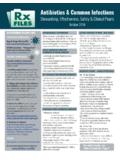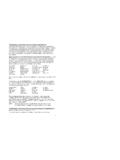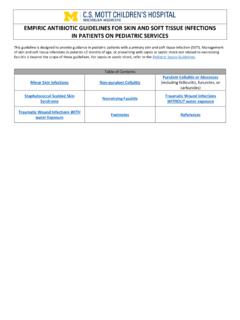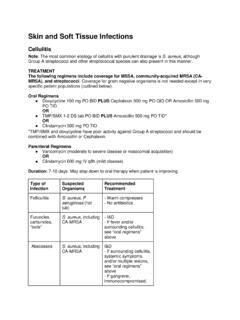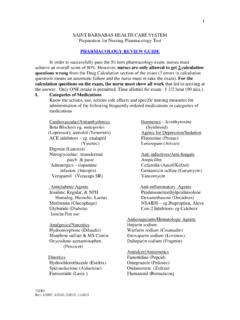Transcription of Microbiology guide to interpreting minimum inhibitory ...
1 Microbiology guide to interpreting minimum inhibitory concentration (MIC). Historically, in vitro susceptibility testing was routinely performed by disk diffusion (Kirby-Bauer) method. The size of the growth- free zone determined whether the bacterium was considered to be susceptible, resistant, or intermediate to a particular antibiotic. Although a useful guide for selecting an effective antibiotic, Kirby-Bauer testing could not tell the clinician the exact concentration of antibiotic needed to achieve a therapeutic result.
2 The alternative automated quantitative method of susceptibility testing with the Vitek platform used in our Microbiology laboratories supports rapid and accurate quantitative antibiotic susceptibility test (AST) reporting, including minimum inhibitory concentration (MIC). The MIC provides the ability to precisely determine the concentration of antibiotic required to inhibit growth of a pathogen. Your IDEXX Microbiology results will show the identity of the organism and the appropriate antibiotic sensitivity pattern against each organism.
3 Most antibiograms will include MICs in order to determine the most effective antibiotic that will result in effective treatment. This guide provides a detailed explanation of the following concepts which are important in implementing the MIC: T. he MIC number is the lowest concentration (in g/mL) of an antibiotic that inhibits the growth of a given strain of bacteria. (See the section What is an MIC? ). An MIC number for one antibiotic CANNOT be compared to the MIC number for another antibiotic.
4 (See the How are MICs used? section.). The choice of antibiotic should not be based on the MIC alone but on several other criteria. (See the antibiotic selection section). The attached tables will aid in MIC interpretation and antibiotic selection. What is an MIC? How is the MIC reported? The MIC, or minimum inhibitory concentration, is the lowest Next to each antibiotic is the susceptibility interpretation: concentration (in g/mL) of an antibiotic that inhibits the growth S (sensitive), I (intermediate), or R (resistant) are the three of a given strain of bacteria.
5 This is a strain dependent value interpretative categories, listed in the first result column of the that will greatly differ between different bacterial species and susceptibility report. The respective category is followed by even within one species depending on the individual strain the MIC in g/mL in the next result column of the susceptibility isolated in the respective clinical case, even for the same report. Sensitive implies that the organism is inhibited by the antibiotic examined. At IDEXX, a commercial automated serum concentration of the drug that is achieved using the system is used to determine MICs.
6 A quantitative method of usual dosage; intermediate implies that the organisms are susceptibility testing, an MIC helps determine which class of inhibited only when higher concentrations than with the usually antibiotic is most effective. This information can lead to an recommended dosages are achievable; and resistant implies appropriate choice of an antibiotic that will increase chances that the organisms are resistant to the usually achievable of treatment success and help in the fight to slow antibiotic serum drug levels.
7 These interpretive standards have been resistance. established by the Clinical and Laboratory Standards Institute The MIC is reported as a numerical value. Values above or (CLSI). The interpretative categories are evaluated according below the range of measurement are indicated with <= (in to the so-called breakpoints for each antibiotic as listed in the case of below the range, in the susceptible category) or with current versions of the CLSI documents. >= (in case of above the range, in the resistant category).
8 Example for reporting AST result Bacteriologic examination, culture aerobic: Staphylococcus intermedius group, moderate count (1). Escherichia coli, high count (2). Antibiogram for strain no. (1) (2) Remark SIR MIC SIR MIC. Penicillin R >= Ampicillin R S <=2 Also valid for Amoxicillin Amoxicillin R S Also valid for Ampicillin Amoxicillin/clavulanic acid S <=2 S <=2. Cefalexin S S <=4. Cefazolin S. Cefalotin S <=2 I 4. Cefovecin S <= S <=0,5. Ceftiofur S <= S <=1. Cefpodoxim S S <=0,25. Cefoperazone S S.
9 Cefquinome S S. Oxacillin S <= S. Cloxacillin S. Gentamicin S <= S <=1. Kanamycin S <=4 Also valid for Neomycin Erythromycin S Tetracycline S <=1 S <=1 Stands for all tetracyclines Doxycycline S <= S 1. Enrofloxacin S <= S 0,5 Stands for all fluorchinolones Marbofloxacin S <= S <=0,5. Pradofloxacin S <= S 0,25. Nitrofurantoin S <=16 S <=16. Clindamycin S Lincomycin S. S <=10 S <=20 Also valid for other sulfonamide/trim. combinations Chloramphenicol S 8 S 8 Stands for all phenicoles ( florfenicol).
10 Florfenicol S S. Imipenem S S <=0,25 Strictly verify indication Meropenem S S Strictly verify indication Amikacin S S <=2 Strictly verify indication Tobramycin S S Strictly verify indication Azithromycin S Strictly verify indication Clarithromycin S Strictly verify indication Interpretation key for the antibiogram: S = sensitive; active substance normally effective against microorganisms at recommended dosage. I = intermediate; active substance may be effective against microorganism at higher than recommended dose.
